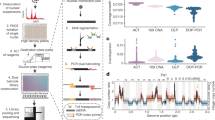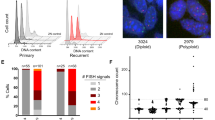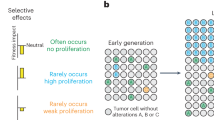Abstract
The conditional expression of activated HER2/neu gene under its endogenous promoter in the mammary epithelium of the mouse results in accelerated lobular development and focal mammary tumors. Carcinogenesis, however, requires amplification and considerably increased expression levels of oncogenic neu. Deducing from the multiple genetic aberrations required for human breast cancer to develop, we hypothesized that in addition to the over-expression of an activated HER2/neu, secondary aberrations would occur. We have therefore conducted a genomic screen for chromosomal imbalances and translocations using comparative genomic hybridization and spectral karyotyping. The results reveal a moderate degree of chromosomal instability and micronuclei formation in short-term cultures established from primary tumors. Genomic instability appears to be linked to the amplification of functional centrosomes, a phenomenon that we frequently observed in other tumor types. Seventy per cent of the tumors revealed genomic amplification of HER2/neu, often in the form of double minute chromosomes, which correlated with recurring loss of mouse chromosome 4D-E, a region that is orthologous to distal human chromosome 1p. It is likely that this region contains putative tumor suppressor genes whose inactivation is required for tumor formation in this model of human breast cancer.
This is a preview of subscription content, access via your institution
Access options
Subscribe to this journal
Receive 50 print issues and online access
$259.00 per year
only $5.18 per issue
Buy this article
- Purchase on Springer Link
- Instant access to full article PDF
Prices may be subject to local taxes which are calculated during checkout






Similar content being viewed by others
References
Alitalo K, Saksela K, Winqvist R, Alitalo R, Keski-Oja J, Laiho M, Ilvonen M, Knuutila S, de la Chapelle A . 1985 Lancet 2: 1035–1039
Amundadottir LT, Johnson MD, Merlino G, Smith GH, Dickson RB . 1995 Cell Growth Differ. 6: 737–748
Andrechek ER, Hardy WR, Siegel PM, Rudnicki MA, Cardiff RD, Muller WJ . 2000 Proc. Natl. Acad. Sci. USA 97: 3444–3449
Bieche I, Champeme MH, Lidereau R . 1994 Cancer Res. 54: 4274–4276
Carnero A, Hudson JD, Price CM, Beach DH . 2000 Nat. Cell Biol. 2: 148–155
Chen X, Zheng Y, Zhu J, Jiang J, Wang J . 2001 Oncogene 20: 769–774
Davisson MT . 1994 Gene 147: 157–160
Garini Y, Macville M, du Manoir S, Buckwald RA, Lavi M, Katzir N, Wine D, Bar-Am I, Schröck E, Cabib D, Ried T . 1996 Bioimaging 4: 65–72
Ghadimi BM, Sackett DL, Difilippantonio MJ, Schröck E, Neumann T, Jauho A, Auer G, Ried T . 2000 Genes Chrom. Cancer 27: 183–190
Ghadimi BM, Schröck E, Walker RL, Wangsa D, Jauho A, Meltzer PS, Ried T . 1999 Am. J. Pathol. 154: 525–536
Heim S, Mitelman F . 1995 Cancer Cytogenetics Wiley-Liss
Hennighausen L. (ed) . 2000 Oncogene (Rev.) 19: 966–967
Isola JJ, Kallioniemi OP, Chu LW, Fuqua SA, Hilsenbeck SG, Osborne CK, Waldman FM . 1995 Am. J. Pathol. 147: 905–911
Kallioniemi A, Kallioniemi O-P, Sudar D, Rutovitz D, Gray JW, Waldman F, Pinkel D . 1992 Science 258: 818–821
Kellogg DR, Moritz M, Alberts BM . 1994 Annu. Rev. Biochem. 63: 639–674
Liu ML, Von Lintig FC, Liyanage M, Shibata MA, Jorcyk CL, Ried T, Boss GR, Green JE . 1998 Oncogene 17: 2403–2411
Liyanage M, Coleman A, du Manoir S, Veldman T, McCormack S, Dickson RB, Barlow C, Wynshaw-Boris A, Janz S, Wienberg J, Ferguson-Smith MA, Schröck E, Ried T . 1996 Nat. Genet. 14: 312–315
McCormack SJ, Weaver Z, Deming S, Natarajan G, Torri J, Johnson MD, Liyanage M, Ried T, Dickson RB . 1998 Oncogene 16: 2755–2766
Muller WJ, Sinn E, Pattengale PK, Wallace R, Leder P . 1988 Cell 54: 105–115
Müller WU, Nusse M, Miller BM, Slavotinek A, Viaggi S, Streffer C . 1996 Mutat. Res. 366: 163–169
O'Brien SJ, Menotti-Raymond M, Murphy WJ, Nash WG, Wienberg J, Stanyon R, Copeland NG, Jenkins NA, Womack JE, Marshall Graves JA . 1999 Science 286: 458–462 479–481
Revillion F, Bonneterre J, Peyrat JP . 1998 Eur. J. Cancer 34: 791–808
Ried T, Just KE, Holtgreve-Grez H, du Manoir S, Speicher MR, Schröck E, Latham C, Blegen H, Zetterberg A, Cremer T, Aver G . 1995 Cancer Res. 55: 5415–5423
Ried T, Knutzen R, Steinbeck R, Blegen H, Schröck E, Heselmeyer K, du Manoir S, Auer G . 1996 Genes Chrom. Cancer 15: 234–245
Ried T, Heselmeyer-Haddad K, Blegen H, Schröck E, Auer G . 1999 Genes Chrom. Cancer 25: 195–204
Schröck E, Badger P, Larson D, Erdos M, Wynshaw-Boris A, Ried T, Brody L . 1996a Hum. Genet. 97: 256–259
Schröck E, du Manoir S, Veldman T, Schoell B, Wienberg J, Ferguson-Smith MA, Ning Y, Ledbetter DH, Bar-Am I, Soenksen D, Garini Y, Ried T . 1996b Science 273: 494–497
Stewart TA, Pattengale PK, Leder P . 1984 Cell 38: 627–637
Tirkkonen M, Tanner M, Karhu R, Kallioniemi A, Isola J, Kallioniemi OP . 1998 Genes Chrom. Cancer 21: 177–184
Wang TC, Cardiff RD, Zukerberg L, Lees E, Arnold A, Schmidt EV . 1994 Nature 369: 669–671
Weaver ZA, McCormack SJ, Liyanage M, du Manoir S, Coleman A, Schröck E, Dickson RB, Ried T . 1999 Genes Chrom. Cancer 25: 251–260
Xu X, Wagner KU, Larson D, Weaver Z, Li C, Ried T, Henninghausen L, Wynshaw-Boris A, Deng CX . 1999a Nat. Genet. 22: 37–43
Xu X, Weaver Z, Linke SP, Li C, Gotay J, Wang XW, Harris CC, Ried T, Deng CX . 1999b Mol. Cell 3: 389–395
Acknowledgements
The authors would like to thank Michael J Difilippantonio, Kerstin Heselmeyer-Haddad, Joseph Cheng and Buddy Chen for critically reading and editing the manuscript. ER Andrechek was supported by the US Army Scholarship #DAMD17-99-1-9285.
Author information
Authors and Affiliations
Corresponding author
Rights and permissions
About this article
Cite this article
Montagna, C., Andrechek, E., Padilla-Nash, H. et al. Centrosome abnormalities, recurring deletions of chromosome 4, and genomic amplification of HER2/neu define mouse mammary gland adenocarcinomas induced by mutant HER2/neu. Oncogene 21, 890–898 (2002). https://doi.org/10.1038/sj.onc.1205146
Received:
Revised:
Accepted:
Published:
Issue Date:
DOI: https://doi.org/10.1038/sj.onc.1205146
Keywords
This article is cited by
-
Tools used to assay genomic instability in cancers and cancer meiomitosis
Journal of Cell Communication and Signaling (2022)
-
Stochastic changes in gene expression promote chaotic dysregulation of homeostasis in clonal breast tumors
Communications Biology (2019)
-
Stromal PTEN determines mammary epithelial response to radiotherapy
Nature Communications (2018)
-
CKAP2 phosphorylation by CDK1/cyclinB1 is crucial for maintaining centrosome integrity
Experimental & Molecular Medicine (2017)
-
RNA:DNA hybrids in the human genome have distinctive nucleotide characteristics, chromatin composition, and transcriptional relationships
Epigenetics & Chromatin (2015)



